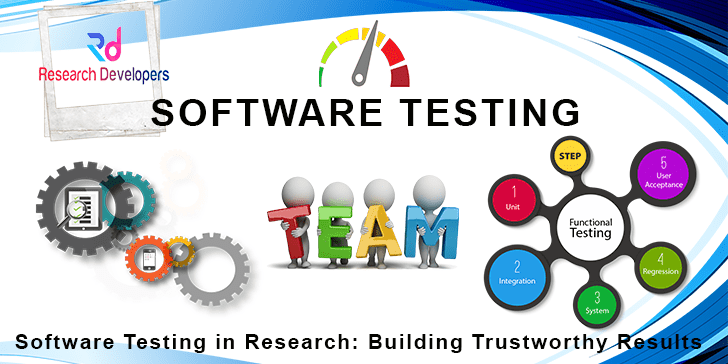Software Testing
Where research begins: Expert guidance on topic selection.

Software Testing
When creating a test case, a test engineer could exclude some circumstances, such as typing in the wrong data or navigation steps, which could affect how the test is executed as a whole. Before the test starts, a single round of permission and evaluation will be carried out in order to prevent this. The test case document’s correctness will decrease if certain test cases are omitted and the review process isn’t completed. All cases must be given to a different test engineer, referred to as a reviewer, for review only after the test case has been written. Analysing test cases is an important part of software testing. The test case covers every feature specified in the software requirement specification. In addition to following the test case authoring principles, the test case should be efficient. To guarantee the test’s success and comprehensiveness, each test case needs to be examined.
The software testing literature began to emerge in the initial 1970s, while it’s possible that the idea of testing predates even the earliest programming experiences: According to Hetzel, the first programme testing conference took place in 1972. Testing was seen as an artistic endeavour, and it was defined as the “destructive” process of running a programme in order to identify faults, as opposed to design, which was considered the “constructive” party. Dijkstra’s most often quoted remark concerning software testing from these years is that it can only reveal the existence of flaws—never their absence.
Testing was elevated to the rank of an engineering profession in the 1980s, and its focus shifted from mistake detection to a more all-encompassing and proactive concept of prevention. Beizer notes that more than just testing, creating tests is one of the most effective ways to prevent bugs. Testing is now defined as a wide, ongoing activity that takes place throughout the development process with the goal of measuring and evaluating software capabilities.
In fact, a lot of the early research has developed into methods and resources that support the systematic integration of this kind of “test-design thinking” into the development process. A number of test process models, the most well-known of which is arguably the “V model,” have been put out for industrial use.
Its numerous variations are all distinguished by testing at least at the System, Integration, and Unit aspects.
In the recent past, some have claimed that the V model’s connotation of a staged as well as formally documented test procedure is wasteful and too bureaucratic, and in favour of more agile procedures. One of the fundamental extreme programming techniques, test-driven development (TDD)[46], is a distinct testing paradigm that is gaining popularity.
One of the core research areas identified in FOSE2000 was the development of an appropriate testing procedure, and this is still an area of active study today.
Test standards. The test criteria set developed by previous research to aid in the test cases methodical identification is incredibly rich. These have historically been classified as either black-box (also known as functional) or white-box (also known as structural), on the basis of whether the source code is used to power the testing. Depending on where the test cases originate, a more precise categorization can be made. There are numerous textbooks and survey papers that offer in-depth explanations of the current standards. In fact, there are now so many factors to consider when making a decision that the true difficulty is in being able to make a decision that is well-founded or, more accurately, in realising how best to combine the criteria. The focus of most recent efforts has been on model-based testing.
Comparing different exam requirements. Many studies have examined the computation of the relative efficacy of the different test criteria, particularly the elements that generate unit technique superior to each other for fault discovery, in addition to the exploration of criteria for test selection and adequacy. Previous research has conducted a number of analytical comparisons between various methods. These investigations, with a special focus on comparing partition (i.e., systematic) vs random testing, have made it possible to build a subsumption hierarchy of relative completeness across equivalent criteria and to comprehend the elements impacting the probability of detecting flaws. In FOSE2000, the goal of “demonstrating effectiveness of testing techniques” was really recognised as a basic research problem. This target is still being pursued today, with an emphasis on empirical assessment.
testing that is object-oriented. In fact, the prevailing paradigm of progress has always served as a catalyst for testing research to find suitable solutions. The testing of object-oriented (OO) software was the main focus in the 1990s. Myth busted: the improved modularity and reuse resulting from OO programming did not necessitate testing at all. Researchers soon found that everything they had learned about software testing broadly was applicable to OO code. Furthermore, new risks and challenges associated with OO programming raised the necessity and complexity of testing.
Encapsulation is one of the basic OO development methods that helps hide issues and make tests harder; inheritance requires a comprehensive retesting of code that has been passed down through the generations; and dynamic binding and polymorphism require new coverage models. Additionally, suitable incremental integration testing approaches must handle the vast array of possible dynamic and static dependencies among classes.
Testing using components. Component-based (CB) development first became popular in the late 1990s as the best method for producing software quickly and with less resources. New difficulties were brought about by testing within this paradigm, which we would categorise as theoretical in nature as opposed to technical. Technically speaking, components need to be sufficiently general to be used in a variety of platforms and settings; as such, the user of the component must retest it in the assembled system in which it is used. The primary issue here, however, is dealing with the dearth of data needed for component testing and analysis that was created outside of the company. In actuality, functional testing requires more information than component interfaces, even though they are described in accordance with certain component models.
Thus, studies have suggested the “contract” that the components follow should be made clear to enable verification and that the required data, or perhaps the test cases themselves (like in Built-In Testing), should be included in the component package to help the component user test the component. One fundamental obstacle in FOSE2000 was testing component-based systems.
Other Services
- PHD & POST DOC Admission counselling
- Topic Section
- Review Paper Writing
- Systematic Literature Review (SLR)
- Research Paper Writing
- Synopsis Writing/Pre thesis writing
- Thesis Writing
- Data Analysis
- Questionnaire Preparation
- Developing Research Framework
- Methodology Development
- MATLAB Implementation
- Matlab Simulation
- Python Implementation
- Machine Learning Implementation
- Deep Learning Implementation
- VHDL Implementation
- Hadoop
- NS2 Implementation
- NS3 Implementation
- ArcGis Mapping & Analysis
- Spss Data Analysis
- Stata Data Analysis
- Amos Analysis
- R Programming
- E-Views Data Analysis
- Minitab Data Analysis
- Software Testing
- Ansys Implementation

